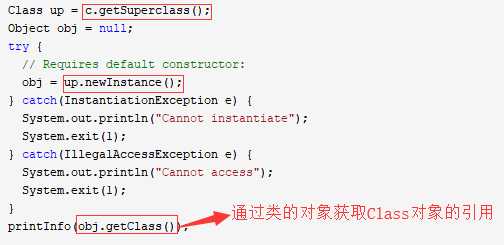标签:我不知道 执行 member default 结构 构造器 null super 完整
在运行状态中,对于任意一个类,都能够知道这个类的所有属性和方法;对于任意一个对象,都能够调用它的任意一个方法和属性。
程序运行时,允许改变程序结构或变量类型,这种语言称为动态语言。
Perl、Python、Ruby是动态语言;C++、Java、C#不是动态语言。
Java程序可以加载一个运行时才得知名称的class,获悉其完整构造,并生成其对象实体,或对其fields设值,或唤起其methods。
反射主要有两个重要功能:
1.可以通过反射机制发现对象的类型,发现类型的方法、属性、构造器。
2.可以创建对象并访问任意对象方法和属性等。
Class类的实例表示正在运行的Java应用程序的类和接口。
通过Class实例可以获取某个类的属性(Field)、构造器(Constructor)、方法(Method)。
程序可以通过Method对象来执行对应的方法,通过Constructor对象来调用对应的构造器创建实例,能通过Field对象直接访问并修改对象的属性值。
Class类与java.lang.reflect类库一起对反射的概念进行了支持。该类库包含了Field、Method以及Constructor类(每个类都实现了Member接口)。这些类型的对象是由JVM在运行时创建的。
每个类都有一个Class对象。
一旦某个类的Class对象被载入内存,它就被用来创建这个类的所有对象。
Class.forName()是取得Class对象的引用的一种方法。
只要你想在运行时使用类型信息,就必须首先获得对恰当的Class对象的引用。
使用Class.forName(),你不需要为了获得Class引用而持有该类型的对象。
class Candy {
static { System.out.println("Loading Candy"); }
}
class Gum {
static { System.out.println("Loading Gum"); }
}
class Cookie {
static { System.out.println("Loading Cookie"); }
}
public class SweetShop {
public static void main(String[] args) {
System.out.println("inside main");
new Candy();
System.out.println("After creating Candy");
try {
Class.forName("Gum");
} catch(ClassNotFoundException e) {
System.out.println("Couldn't find Gum");
}
System.out.println("After Class.forName(\"Gum\")");
new Cookie();
System.out.println("After creating Cookie");
}
}输出结果:
inside main
Loading Candy
After creating Candy
Loading Gum
After Class.forName("Gum")
Loading Cookie
After creating Cookie注意:在传递给Class.forName()的字符串中,你必须使用全限定名(包含包名)。
如果你已经拥有一个类型的对象,那就可以通过调用getClass()方法来获取Class引用了。
package typeinfo.toys;
interface HasBatteries {}
interface Waterproof {}
interface Shoots {}
class Toy {
// Comment out the following default constructor
// to see NoSuchMethodError from (*1*)
Toy() {}
Toy(int i) {}
}
class FancyToy extends Toy
implements HasBatteries, Waterproof, Shoots {
FancyToy() { super(1); }
}
public class ToyTest {
static void printInfo(Class cc) {
System.out.println("Class name: " + cc.getName() +
" is interface? [" + cc.isInterface() + "]");
System.out.println("Simple name: " + cc.getSimpleName());
System.out.println("Canonical name : " + cc.getCanonicalName());
}
public static void main(String[] args) {
Class c = null;
try {
c = Class.forName("typeinfo.toys.FancyToy");
} catch(ClassNotFoundException e) {
System.out.println("Can't find FancyToy");
System.exit(1);
}
printInfo(c);
for(Class face : c.getInterfaces())
printInfo(face);
Class up = c.getSuperclass();
Object obj = null;
try {
// Requires default constructor:
obj = up.newInstance();
} catch(InstantiationException e) {
System.out.println("Cannot instantiate");
System.exit(1);
} catch(IllegalAccessException e) {
System.out.println("Cannot access");
System.exit(1);
}
printInfo(obj.getClass());
}
}输出结果:
Class name: typeinfo.toys.FancyToy is interface? [false]
Simple name: FancyToy
Canonical name : typeinfo.toys.FancyToy
Class name: typeinfo.toys.HasBatteries is interface? [true]
Simple name: HasBatteries
Canonical name : typeinfo.toys.HasBatteries
Class name: typeinfo.toys.Waterproof is interface? [true]
Simple name: Waterproof
Canonical name : typeinfo.toys.Waterproof
Class name: typeinfo.toys.Shoots is interface? [true]
Simple name: Shoots
Canonical name : typeinfo.toys.Shoots
Class name: typeinfo.toys.Toy is interface? [false]
Simple name: Toy
Canonical name : typeinfo.toys.Toy下面的代码片段就是通过getClass()来获取Class引用的。


Class的newInstance()方法表明:“我不知道你的确切类型,但是无论如何要正确地创建你自己”。
使用newInstance()来创建的类,必须带有默认的构造器。
标签:我不知道 执行 member default 结构 构造器 null super 完整
原文地址:https://www.cnblogs.com/gzhjj/p/8997984.html